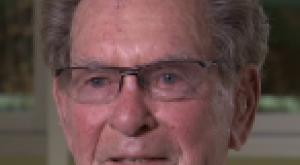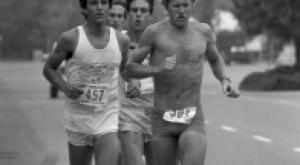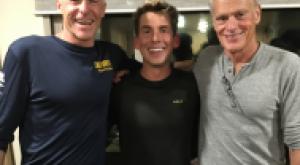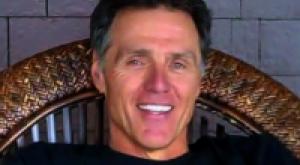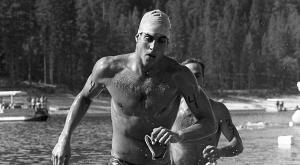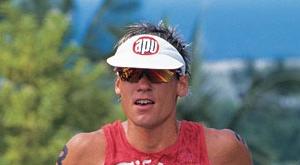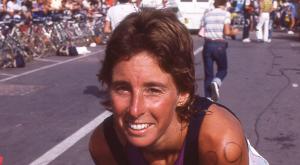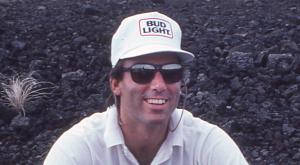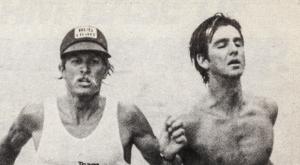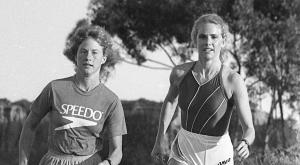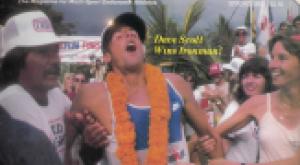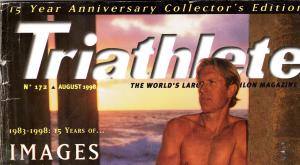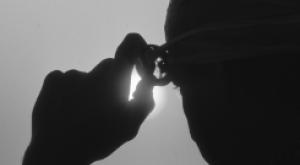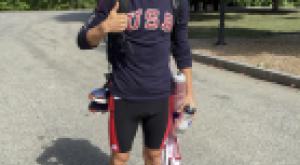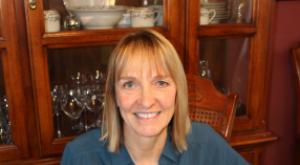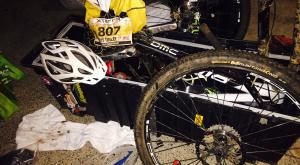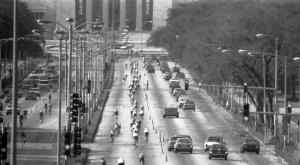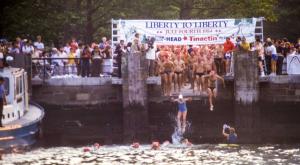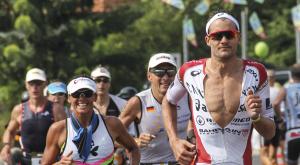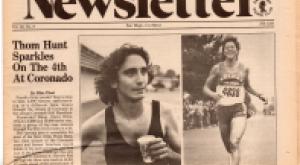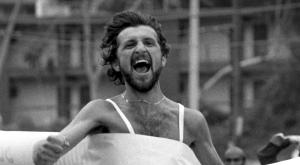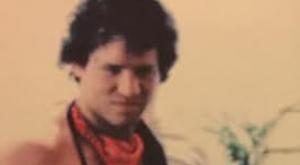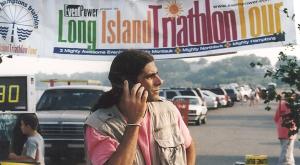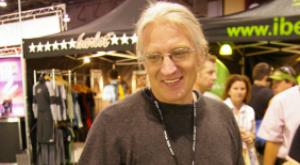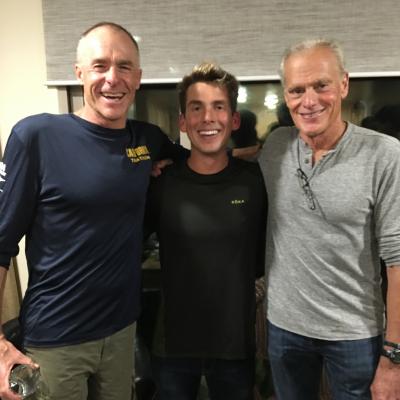
Jason Cambell (left) and the author (right) hang out with US Olympic triathlete Joe Maloy. Harper is now a law partner at Bowles & Verna LLP in Walnut Creek, Calif. He is also the head coach for the University of California/Berkeley triathon team. In his day, Dean Harper was among the top professional triathletes in the world -- about as close as you could get to being one of the Big Four without being named Scott or Mark.
Before triathlon existed in Northern California, I raced triathlon Hall of Famer, Dave Scott, in a run-swim event. It was August of 1976 and the race was held at Pacific Shores in Redwood City, California. I’d known Dave from collegiate swimming and water polo but failed to ask him why he was warming up for a run-swim by riding his bike. It turns out, later that year he’d compete in perhaps the first triathlon in Northern California. In November 1976, Dave and his dad, Vern Scott, the first president of the USAT, competed in a nine-mile bike, four-mile run and a fifteen hundred-meter swim. The event produced by the Dolphin Club, was staged in and around San Francisco’s famed Aquatic Park.
I didn’t become aware of triathlon until March 23, 1980, when I watched Dave on Wide World of Sports winning his first of six Hawaiian Ironman titles. I was heading off to law school at Hastings in San Francisco in 1980, but I knew I wanted to participate in a triathlon. As it turned out, the Northern California triathlon scene was just emerging in 1981. At least two other Northern California triathlons existed prior to 1981 – the Lodi Triathlon beginning in August 1979, and the Davis Triathlon, beginning in October 1979.
In 1981, after my first year of law school, I competed in every Northern California triathlon I could find. There was no internet or easy way to find information about events. I combed through all the local sports publications, most notably a San Francisco publication called City Sports; a free sports magazine that listed all local running and triathlon events in Northern California. For years, City Sports was delivered monthly to local running stores, swim centers, and bike shops. City Sports was the go-to source for endurance events in the early 1980’s.

Trophy mug from the 1981 Lodi Triathlon. Great for spare change.
The first triathlon on the 1981 NorCal circuit was in Lodi, August 1981. At the time, and perhaps still, if you knew the town of Lodi it was from the same-titled 1969 Creedence Clearwater Revival song. The oft repeated John Fogarty lyric “stuck in Lodi again” resolved the refrain but had nothing to do with sport. Originally, the song was released on the B-side of CCR’s hit “Bad Moon Rising.” Fogarty’s song is about a down-and-out musician who plays a small gig in Lodi but can’t afford to leave the Northern California central valley. The irony that an emerging and extreme sport would eventually bring economic boom to small towns (Kona, Penticton, Roth et al.) around the world is lost to sport historians.
On August 7, 1981, approximately 250 athletes competed in the third annual Lodi Triathlon put on by the race’s prior winner, John Griffin, a local Fleet Feet owner. Fleet Feet sponsored the race in connection with the Lodi’s Recreational Department. Among the participants was Les Waddel, whose daughter Alexis became one of the top Northern California professional triathletes a few decades later. The race began with a 5K trail run, was followed by a 5-mile bike, and finished with a 1,000 yard swim in a small lake. After the 5K trail run we hopped on our bikes and blew through stop signs and stop lights with no police protection. I managed to take the lead on the bike and held it to the finish. The trophy mug I won I have used for spare change for 35 years.
After that first win I was hooked. If there had been an established pro circuit at the time, I may never have finished law school. My wife, Mary Ann, would say that it was the beginning of my lifelong love affair with the sport of triathlon.

The author, bearded at the time, at the Sierra Nevada Triathlon in 1981.
Next up in 1981, the granddaddy of Northern California triathlons at the time--the Sierra Nevada Triathlon—was staged as a 2 mile swim, 55 mile bike, and a half marathon trail run. Triathlon distances were far from standardized at the time, but this one came very close to the now standard 70.3 half Ironman distance. The actual swim distance turned out to be closer to 2.4 miles. Several of the early 1980 swims were measured by buoys being dropped when “this looks about right.” My personal T-I (not yet so named) included lacing up my cycling shoes -- a pair of Nike Waffle Trainers that cinched down in place with the toe strap pedals of the day.
The Sierra Nevada bike course was similar to the not yet invented Wildflower course, with some tough climbs. The run was also very similar to the Wildflower run course, primarily on hilly trails. First prize was a trip to the Ironman in Hawaii for the February 1982 race. The race, on the men’s side, was very close with Grant Boswell, me, and Scott Molina finishing in that order, all within a minute and twenty seconds of each other. Grant took the money, but decided not to compete in Hawaii that year. He would, however, go on in later years to win Ironman Australia, finish in the top ten in Hawaii and race several years as one of the top pros.
The female winner that first year was Eva Oberth, who had played water polo and ran track at Chico State. She had also won the Lodi race earlier that year.

Dave Horning won the Davis Triathlon in 1981. He was a big man for a triathlete, but he handled the cold water better than almost everyone.
On a chilly morning in early October, 1981, in the college town of Davis, California, as I was getting ready for my third triathlon, I heard that some boys from Southern California were up to race. It turns out that Scott Tinley, Mark Montgomery, and other top triathletes from So Cal had made the trek up to the Central Valley town to compete.
The race began with a 10k run. We then hopped on our bikes for a flat 20-mile bike ride through the agrarian countryside of Davis. I ended up in a bike pack of four or five riders; drafting was not yet completely illegal, race marshals were not yet a thing, and few truly understood the benefits to riding in close proximity. I still remember that Les Waddel, Mark Montgomery, and several other athletes were cycling together--we didn’t know each other--and I innocently asked, “Who can swim?” Mark Montgomery was the only one to speak and said “I can.” It turns out that most of us couldn’t – not after a hard 10K run, 20 mile bike, and then a 60-degree, 1½ mile swim with no wetsuits.
This was two years before wetsuits were allowed in any race. When I hit the water in that lead group, every muscle in my body cramped up within a few hundred yards. I remember saying after the race that I had cramps in muscles that I didn’t even know existed. Many athletes were pulled from the wreckage. Fortunately, no one drowned. I think I managed to finish fifth. Dave Horning, who probably weighed 200 pounds, but was, for a couple years, an amazing endurance athlete, came from behind and managed to pass the rest of us who were struggling with cramping muscles from head to foot. Dave swam regularly in the San Francisco Bay with the Dolphin Club and was accustomed to cold water swims. It wouldn’t be my last race against Dave Horning in 1981.
In the early 1980’s pioneering triathletes were guinea pigs. Race directors were trying to figure things out and, for those first few years, a number of the early races had the wetsuit-less swim last. Why? Primarily because the small bodies of water didn’t lend themselves well to mass starts, and wave starts hadn’t yet been invented. The last race on the 1981 circuit, however, had the swim first, but it too was quite a challenging swim.
By October 1981, local NorCal triathletes heard about another race. A few of us had done a test run with some of the San Francisco Olympic Club and Dolphin South End Club athletes. The race director scheduled the first annual Escape from Alcatraz for November 1, 1981 (TriHistory, July 11, 2015). The initial course was truly epic, combining the 1.5-mile Alcatraz swim, a 14-mile bike across the Golden Gate Bridge to Mill Valley, and then the Double Dipsea run in reverse: 14.8 miles on the legendary Dipsea course, the oldest trail race in America. I knew that I would have trouble with cold water, even though I had been a collegiate swimmer and was swimming between 20,000 and 25,000 yards a week.
For one month before the event, I took cold showers because I’d had read somewhere that it helped the athlete acclimatize to cold water. It was ridiculously un-fun and it didn’t help me at all.
I’d traveled to pre-swim the course at the San Francisco Aquatic Park cove, where Dolphin Club and South End Club athletes swam regularly with no wetsuits. One of the members at the time was the legendary Walter Stack, who claimed to have been the only Alcatraz prisoner to have “escaped” from the island. (He actually had been incarcerated on Alcatraz in the late 1920s, when as a teenager he served 18 months for desertion at what was then the U.S. Army’s Disciplinary Barracks.)
With all due respect to Frank Morris, who some say actually did escape from Alcatraz in 1962 (he was portrayed by Clint Eastwood in the 1979 movie, Escape from Alcatraz), Stack may be the only person to have ever accomplished the Alcatraz prisoner/swimmer double.
I believe that Stack also has the record for the slowest time ever in the Hawaii Ironman, having completed the race in 26 hours well before the current 17-hour cut-off rule.
After one month of cold showers and swimming in the Bay with only a Speedo, cap and goggles, I was hoping I could handle the 59-degree water. However, the week of the race a storm came in and on race the day the water temperature had dropped to 55 degrees.
I had been contacted by a few Dolphin Club members who, for whatever reason, did not want Dave Horning to win the first Escape. They set me up with an experienced oarsman to follow closely. He put an orange life preserver on the back of the boat and told me that when the race started, just to follow him. The currents can be a little tricky in the San Francisco Bay and having an experienced oarsman who knew the currents was an advantage. Sighting can also be difficult when the fog rolls in.
The ferry boat that took the 100-person limited field to Alcatraz Island stopped about 100 yards from Alcatraz. They then announced that we would dive off the boat and swim to a small beach so that we would actually start on the Island. It was 50 degrees at best outside. The water temperature was 55 degrees. We had no wetsuits. I didn’t even know about neoprene caps. We swam to the shore and stood waiting for the start. At six feet, one-hundred and sixty-one pounds, I was lean-Dean and freezing my butt off. We shivered on that small Alcatraz beach before the race even started.
Once the race started, I took off and was swimming side by side with Dave Horning. At some point a few hundred meters from shore, I lost all coordination. A friend who was watching from shore told me later that it looked like someone had hit me over the head with a baseball bat. Somehow, I managed to make it to shore and promptly passed out on the beach. Outside aid was permitted at the time and friends and family helped get me dressed and on the bike.
I passed out again about a half mile onto the bike course – fortunately I was not yet on the Golden Gate Bridge. Someone yelled to me to get up and I was on my bike again. I was so hypothermic (or what Tri-Athlete Magazine editor and founder, Bill Katovsky, termed a few years later “Harperthermic”) that I actually started warming up, then began to feel cold. I had reached a point where I was beyond cold.
By the time I hit the double Dipsea trail, I was fifteen to twenty minutes behind. I had the fastest run of the day at one hour and 55 minutes, but couldn’t close the gap on Mr. Horning and finished second. The double Dipsea was an out and back course, but there were shortcuts. Dave Horning knew the shortcuts. I did not. I never saw him, even though the course was out and back. I actually thought I had the lead on the way back since I saw all the other top competitors on the way back except Dave. I thought he had dropped out.
Anyway, that first Alcatraz race was an adventure on an iconic course and, as I’ve told my kids and will tell my grandkids, I actually survived a non-wetsuit swim from Alcatraz Island to the mainland at Aquatic Park. Perhaps Frank Morris did escape from Alcatraz back in 1962. As an aside, my friend Matt Lieto often introduces me as perhaps the only person to have finished the Escape without wearing a wetsuit and the Hawaii Ironman wearing a wetsuit, when they allowed wetsuits one year in 1986. I wouldn’t recommend either.
The question might be asked, “Why did triathlon emerge at the same time in various parts of California with entirely different and unrelated race directors? In the 1979-1983 time period, several races emerged independently of one another both in Northern California and Southern California. How and why did race directors in various venues all come up with the idea of a swim, bike, run event--a triathlon--independently? I have some facts and a couple theories:
First, an article about the second Hawaii Ironman race appeared in Sports Illustrated on May 14, 1979. Barry McDermott, who was on the Island of Oahu covering a golf tournament, ended up writing a ten-page, 6500 word story in Sports Illustrated after witnessing the event (TriHistory, Jan 2014). The article was primarily about Tom Warren winning the Ironman in the year 1979.
The second likely impetus was Dave Scott appearing in the Wide World of Sports coverage of the 1980 race in Hawaii. Before CNN, Sports Channel, ESPN, and literally hundreds of TV stations, there were three major networks and no sports channels. ABC’s Wide World of Sports was the most popular and most watched sports show in America in 1980. I remember seeing Dave in the 1980 broadcast just before I started law school. I swam and played water polo against Dave and said to myself, like perhaps thousands of others around the country, “I want to compete in a triathlon.” Then, of course, with Julie Moss’s dramatic crawl across the finish line in the February 1982 Ironman--also chronicled on Wide World of Sports--the sport got an even bigger boost.
John Griffin, the race director for the Lodi event in 1979, had been a San Diego State student and had competed in a couple of Fiesta Island triathlons in San Diego. Fiesta Island, situated in the middle on San Diego’s four-thousand-acre aquatic playground, Mission Bay, is credited with being the birthplace of triathlon in 1974. John grew up in the Central Valley and moved back to Lodi in 1978 and, together with his father, opened a local Fleet Feet store. After his experience with the Fiesta Island events, and after reading Barry McDermott’s article, he decided to start the Lodi Triathlon in 1979. He won that first race. The event lasted ten years until the race became more than John and his wife Cindy, could handle. John recalls that he just didn’t have the time and ability to continue to put on the race.

Memorabila from the inaugural Escape From Alcatraz triathlon: finisher's shirt and belt buckle. There were no awards for hypothermia.

Sally Edwards' seminal book, published in the Spring of 1983.
Ask any historian of the sport of triathlon, “Where was triathlon’s first mecca?” The answer is, of course, “San Diego.” San Diego was home to the 1979 Ironman Triathlon winner Tom Warren, 1981 winner John Howard, February 1982 and 1985 winner Scott Tinley, six-time winner Mark Allen, and the infamous J. David Team of the early 1980’s. However, I maintain that Northern California was triathlon’s first mecca. Several classic races, such as Escape from Alcatraz beginning in 1981, USTS San Francisco beginning in 1982, and Wildflower beginning in 1983 are all Northern California venues.
Many of the early 1980’s top ranked triathletes: Dave Scott from Davis, Scott Molina from Pittsburg, and by 1984, Mike Pigg from Arcata, hailed from NorCal. There were other top ten-ranked male triathletes from Northern California; I was consistently in the top ten rankings from 1982 to 1986. Grant Boswell, originally from Chico, was one of the top American pros, both on the USTS circuit, and with some top ten finishes in Hawaii. (After a pro race in Bend, Oregon in 1985, I remember hanging out with Grant. He was living in Chico at the time, but said, “I love it here, I’m moving.” He did, and I understand from my Bend connection – Matt Lieto – that Grant still lives in Bend. Grant’s son, Ian, currently rides for Team Sky.)
Scott Molina, of course, went on to win over a hundred pro races, was one of the Big Four, won the Hawaii Ironman in 1988, the World’s Toughest Triathlon in Lake Tahoe twice, and won countless USTS races. Scott’s brother, Sean, was also one of the country’s top triathletes of the early to mid-1980’s.
There was the entire Hinshaw family: Jennifer, who won the first Wildflower race in 1983; Brad, who set the Hawaii Ironman swim record that stood for years; and Chris, who was second to Scott Tinley in the 1985 Ironman. The Hinshaw family lived in the Silicon Valley and their dad, Ed, then a top masters swimmer and triathlete, built a twenty-five yard pool in their back yard. Brad’s three sons were two-time Olympic Trials qualifiers, two of whom swam at UC Berkeley with my son Greg and daughter Shelley.
Several of the sports’ early female stars also hailed from Northern California. The 1982 Sierra Nevada race witnessed on the women’s side the emergence of two early female stars, Liz Applegate and Linda Buchanan, who placed first and second, respectively. After a brief pro triathlon career which included wins at the USTS San Francisco and the USTS Portland, Applegate earned her Ph.D. in Nutrition and taught at UC Davis in the sport’s nutrition department for many years. She is now a nationally renowned expert in nutrition and author of several nutrition books and countless nutrition articles for Runner’s World and other publications. I understand from my UC Davis connections that she was a wildly popular UC Davis professor.
Linda Buchanan was one of the top female athletes on the USTS circuit, won the 1983 Nice France World Championship, and countless other races around the world. Joanne Dahlkoetter, who placed second in the 1983 Hawaiian Ironman World Championship, was from San Francisco, and Ardis Bow, another top female pro of that era, also hailed from Northern California.
On the multisport media side, TriAthlete Magazine was founded in 1982 by UC Berkeley grad and Berkeley resident, Bill Katovsky. Sacramento resident Sally Edwards finished second in the 1981 Hawaiian Ironman, and in 1982 published what is regarded as the first triathlon book, Triathlon, A Triple Fitness Sport: The First Complete Guide to Challenge You to New Total Fitness, which offered readers a simple place to begin their forays into the sport. Sally was one of the founders of the Fleet Feet chain of running stores, which became a national chain with several dozen franchises. Edwards also produced what may have been the first triathlon training camp in Squaw Valley in 1983.
Marc Evans, from Lafayette, California at the time, was probably the first full time triathlon coach, having founded Triathletics West in 1982 (link here). Tri-Fed (now USA Triathlon) had an original Board of Directors made up predominately of Northern California triathletes, including Dave Scott’s father, Vern, as the first president. Vern was a professor at UC Davis.
With the number of events, athletes, and contributors to the early days of triathlon, if not the first mecca, Northern California’s early contributions to the sport of triathlon were significant.
More than two decades after that period, in the spring of 2007, I was sitting with Wildflower Triathlon Race Director Terry Davis, after racing the event. The Wildflower race was at its peak of nearly seven thousand athletes and eight thousand family and supporters. Terry directed the event, and I had competed in the first Wildflower race in 1983 with approximately eighty athletes. We thought back to that first race and both of us acknowledged that neither of us could have predicted the incredible popularity and worldwide growth of the sport. I thought back to my first year in the sport and realize that, for a brief period of triathlon history, Northern California may very well have been, at the time, the center of the very small triathlon universe.

